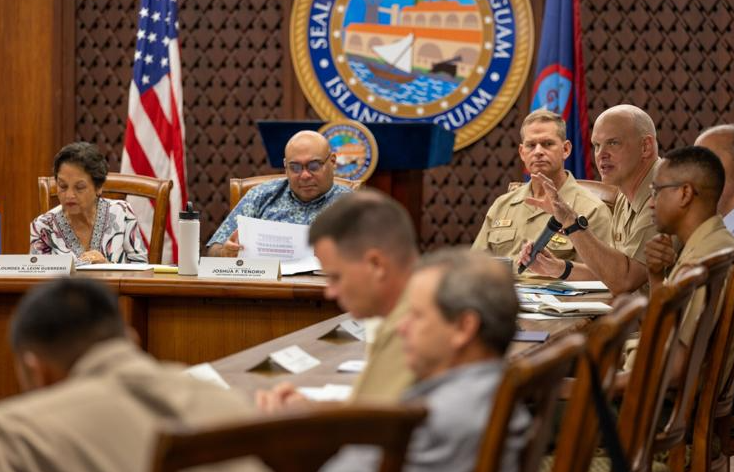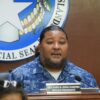
By Walter Ulloa
For Variety
HAGÅTÑA (The Guam Daily Post) — The Leon Guerrero administration is working to address persistent questions about transparency and community input as Guam’s military buildup accelerates, with officials defending their coordination efforts while legislators and residents continue pressing for more direct communication from defense leaders.
Vera Topasna, executive director of the Community Defense Liaison Office, told The Guam Daily Post that the administration takes community concerns seriously and that agency heads maintain direct communication with military and federal counterparts on infrastructure needs without waiting for formal meetings.
“Many of our cabinet officials are closely tracking issues and working with the military and federal regulatory partners to ensure full compliance with environmental, cultural, and other policy agreements in place,” Topasna said.
The comments come after the Nov. 14 Civil-Military Coordination Council meeting at the Ricardo J. Bordallo Governor’s Complex, where Gov. Lou Leon Guerrero and Rear Adm. Brett Mietus, commander of Joint Region Marianas, co-chaired discussions between U.S. military officials and Government of Guam agency representatives.
Leon Guerrero affirmed the need for steady coordination as Defense of Guam projects move forward.
“As we build Guam’s readiness and resilience, today’s dialogue underscores our shared responsibility to protect our island and support our people,” Leon Guerrero said in a press release last week from JRM and Joint Task Force-Micronesia. “Effective coordination ensures that decisions reflect our community’s needs as well as national security priorities.”
Lt. Gov. Joshua Tenorio emphasized early alignment on infrastructure and workforce planning.
“Guam’s security and prosperity rely on our ability to coordinate across civilian and military agencies,” Tenorio said in the release. “By improving communication and addressing infrastructure and workforce challenges early, we strengthen our preparedness and build a more resilient island for all who call Guam home.”
Mietus presented a partnership alignment plan intended to streamline communications across departments.
“As Guam continues to serve a critical strategic role, it is important to emphasize the significance of balancing military development to support operational readiness while preserving the island’s unique environment and quality of life for residents,” Mietus said in the release.
Rear Adm. Joshua Lasky, commander of Joint Task Force-Micronesia, stressed the importance of unified action.
“Defense of the island and region cannot be overstated in today’s era of geopolitical tensions when national security and deterrence are of great significance,” Lasky stated in the release. “As challenges and threats become increasingly complex and interconnected, it is essential for us, as one unified community, to stay aligned in our goals and collaborate effectively.”
The meeting addressed military mission growth, solutions to H-2B labor demands for both military and private sector construction, and Defense of Guam initiatives.
Topasna revealed that draft legislation is under review between the administration, JRM, Indo-Pacific Command, and Congress to address H-2B labor shortages for both private and military construction projects on Guam.
“This legislation reflects the ‘OneGuam’ commitment to ensure a balanced solution to potential labor shortages for critical infrastructure and industry needs on and off military installations,” Topasna said.
The Defense of Guam working group provided updates and discussed tabletop exercises designed to address cybersecurity, readiness, and improve communications across civilian and military communities.
Topasna said the administration continues working with the military, federal partners, and Congress on workforce and infrastructure needs. Many agencies have received federal grants to administer programs that strengthen Guam’s workforce, with significant progress in expanding apprenticeship programs through partnerships with the Department of Labor, Guam Community College, and other educational institutions.
The administration has communicated priorities to the military, federal partners, and Congress that include utilities, roads, ports, airports, and healthcare.
“These systems are essential lifelines for our people and remain at the forefront of discussions between our administration, agency leadership, and federal partners,” Topasna said.
The administration continues receiving Defense Access Road funding for roadway improvements and infrastructure upgrades at the Port Authority while working on critical airport requirements. Healthcare, particularly a new hospital, remains a top priority.
Topasna said the CMCC convenes senior leaders from the government, JRM, JTF-Micronesia, and relevant federal partners.
“The agency heads work in real time with the military as needed to address any regulatory concerns through the permitting process or monitoring agreements and do not wait for a CMCC meeting to address concerns,” Topasna said.
The administration continues increasing transparent communication through meetings, public hearings, and media releases. The Community Defense Liaison Office launched its new website in September to provide further details to the public.
“As much as possible, without compromising security, we are updating the public,” Topasna said.
However, transparency concerns persist. At the Guam Defense Forum earlier this year, activist Monaeka Flores challenged military officials’ repeated references to Guam as part of the U.S. homeland.
“This doesn’t matter how many times you say ‘homeland’ over and over and over again; this is not your homeland. This is our homeland,” Flores said during a panel discussion.
Sen. Telo Taitague, who chairs the military buildup oversight committee, has pressed for direct communication between military leaders and the legislative branch. At last month’s Association of Pacific Island Legislators meeting in Saipan, Taitague confronted a Joint Region Marianas representative about why the military briefs the governor’s office but bypasses the legislature.
“How are you going to be more transparent to the Legislature, the second branch of government? Why haven’t you engaged the legislature to give us information?” Taitague asked.
Taitague said the current system leaves legislators unable to answer constituent questions about military activities affecting their communities. She spoke with Lasky, who acknowledged problems with how information flows to territorial legislatures and said new systems are needed to keep lawmakers informed.
“Communication is key, especially as we grapple with impacts to our infrastructure and cost of living,” Taitague said in a press release issued after the APIL meeting.
The Navy is projecting approximately 10,000 additional active-duty personnel, dependents, and government civilians will arrive over the next decade as the military buildup continues.
The CMCC was established in 2010 to foster collaboration among the Department of Defense, local government, and federal agencies to share information, discuss, and provide recommendations for military activities on Guam. The next CMCC meeting is scheduled for February.
As of press time Tuesday, JRM U.S. Navy Rear Adm. Brett Mietus and Rear Adm. Joshua Lasky, commander of JTF-Micronesia, had not responded to requests for comment.











